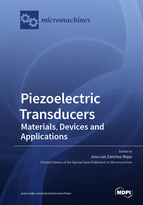Piezoelectric Transducers: Materials, Devices and Applications
A special issue of Micromachines (ISSN 2072-666X). This special issue belongs to the section "A:Physics".
Deadline for manuscript submissions: closed (30 September 2019) | Viewed by 121368
Special Issue Information
Dear Colleagues,
Advances in miniaturization of sensors, actuators, and smart systems are receiving substantial industrial attention, and a wide variety of transducers are commercially available or with high potential to impact emerging markets. Substituting existing products based on bulk materials, in fields such as automotive, environment, food, robotics, medicine, biotechnology, communications, and other technologies, with reduced size, lower cost, and higher performance, is now possible, with potential for manufacturing using advanced silicon integrated circuits technology or alternative additive techniques from the mili- to the nano-scale.
In this Special Issue, which is focused on piezoelectric transducers, a wide range of topics are covered, including the design, fabrication, characterization, packaging, and system integration or final applications of mili/micro/nano-electro-mechanical systems based transducers:
- Materials research oriented towards piezoelectric transducers and intelligent systems
- Processes and fabrication technologies for piezoelectric sensors and actuators
- Modelling, design, and simulation of piezoelectric transducer devices
- Devices and circuits for Internet of Things focused on piezoelectric transducer applications
- Resonant and travelling wave piezoelectric sensors and actuators
- Chemical and bio-transducers based on piezoelectric devices
- Calibration, characterization, and testing techniques
- Reliability and failure analysis
- System integration, interface electronics, and power consumption
- Applications and markets, and control and measurement systems
Prof. Jose Luis Sanchez-Rojas
Guest Editor
Manuscript Submission Information
Manuscripts should be submitted online at www.mdpi.com by registering and logging in to this website. Once you are registered, click here to go to the submission form. Manuscripts can be submitted until the deadline. All submissions that pass pre-check are peer-reviewed. Accepted papers will be published continuously in the journal (as soon as accepted) and will be listed together on the special issue website. Research articles, review articles as well as short communications are invited. For planned papers, a title and short abstract (about 100 words) can be sent to the Editorial Office for announcement on this website.
Submitted manuscripts should not have been published previously, nor be under consideration for publication elsewhere (except conference proceedings papers). All manuscripts are thoroughly refereed through a single-blind peer-review process. A guide for authors and other relevant information for submission of manuscripts is available on the Instructions for Authors page. Micromachines is an international peer-reviewed open access monthly journal published by MDPI.
Please visit the Instructions for Authors page before submitting a manuscript. The Article Processing Charge (APC) for publication in this open access journal is 2600 CHF (Swiss Francs). Submitted papers should be well formatted and use good English. Authors may use MDPI's English editing service prior to publication or during author revisions.
Keywords
- Piezoelectric devices
- Sensors
- Actuators
- MEMS
- NEMS
- Smart Systems
- Microsystems
- Miniaturization
- Polymers
- Additive manufacturing






